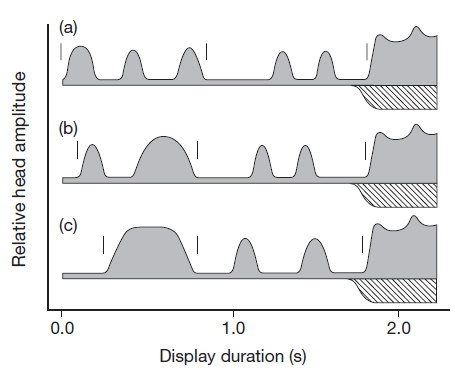

| Visitors Now: | |
| Total Visits: | |
| Total Stories: |
Are You Displaying At Me? There’s No One Else Here…

Three stereotyped head-bobbing patterns of A. carolinensis. The black area represents the amplitude of the head as it moves up and down. Although amplitude can vary within and among individuals, the cadence remains constant for each of the display types. The hatched area refers to times when the dewlap is displayed. Length and number of dewlap displays and associated headbobs at the end of the display can be quite variable. This figure is a modification from Jenssen et al. (2000) that appeared in Lizards in an Evolutionary Tree.
Anole displays have proven to be as frustrating as they are fascinating. These displays, which are species-specific and typically involve headbobs and/or pushups that may or may not be accompanied by dewlap extensions, are as varied as one might expect within a group as diverse as Anolis. However, despite concerted efforts by an energetic group of researchers aimed at understanding the form, context and meaning of these varied adult male displays, a complete understanding of this complex signal eludes us. The stereotyped displays exhibited by many anole species are of particular interest, and of these, arguably the best-studied are the A, B, and C displays of that lab rat of the anole world, Anolis carolinensis.
In a recent paper, Jenssen and collaborators report a characteristically detailed and rigorous field study on the use of such stereotyped displays in both breeding and postbreeding free-ranging A. carolinensis males. Through painstaking analysis of videotapes of thousands of undirected male displays in nature with no obvious receiver, they show, among other results, that breeding males in “monitor” mode (i.e. lizards that signal while stationary) used mostly C displays, but increased use of A and B displays while moving or “travelling.” Monitoring lizards also exhibited an overall lower display rate than travelling males, and used more and longer volleys of displays. Additionally, about a third of all displays had an extra “shudderbob” tacked on. These patterns held through the postbreeding season. Interestingly, Jenssen et al. note that these undirected displays aimed at no-one in particular are most similar to aggressive signals used by males engaged in contests. The implication is that these undirected displays are in fact directed at an unidentified (or undetected) rival male audience, rather than being for the benefit of any single lady lizards in the area.
The notion of males displaying aggressively just in case any rivals might be present makes sense for a species such as A. carolinensis that defends areas harbouring females, rather than trying to attract them. One wonders if this result would hold for species that place less emphasis on territory defense and that have been rumoured in the past to exhibit signs of female preferences (Anolis valencienni, anyone?).
2012-11-15 21:41:10
Source: http://www.anoleannals.org/2012/11/15/are-you-displaying-at-me-theres-no-one-else-here/
Source:



